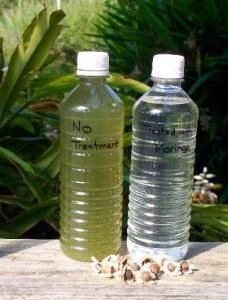
The challenge of improving water quality in water-stressed areas of the world may have a natural champion in the Moringa oleifera tree. More specifically, a particular protein found in the meal of dried and ground M. oleifera seeds, when adsorbed onto sand, has shown some excellent preliminary results in removing total suspended solids (TSS) and in killing coliform bacteria. Dr. Darrell Velegol of Penn State University presented some preliminary results.
The Moringa oleifera tree
Moringa Oleifera is a fast growing (15 feet/year) crop tree that is well suited to prosper in the equator belt climates with non-boggy soils. It produces an extremely nutritious leaf that contain the following on a per-pound basis:

- 7x the vitamin C as oranges
- 4x the vitamin A as carrots
- 4x the calcium of milk
- 3x the potassium of bananas
- 2x the protein of yogurt
In addition, the seed oil can be used for fuel, as well as for cosmetic and medicinal purposes. What's more, it also produces a truly amazing seed.
Seeds preparations
The tree's seed grow in pods. When dried, hulled, and ground, the meal was found to have a significant ability to reduce the suspended solids in extremely turbid waters. In addition the suspended m. oleifera seed meal somehow have the ability to reduce E. coli contaminations.

However, a drawback to treating water with the seed meal is that its organic materials are also an excellent source of nutrients for other bacterial activity, thus causing the water to foul quickly.
In an effort to eliminate this problem, trials were performed to determine if the active ingredients could be adsorbed on a solid substrate, thus allowing the inactive organics to be washed from the active agents, and (hopefully) maintain the desired properties. The result was coined "F-sand" and was found to be as effective as the raw meal.
The Moringa protein and water treatment results
The Moringa oleifera coagulation protein (MOCP) seems to work in two distinct ways:
- The cationic nature of the high level of arginine moieties in the protein provides for solids adsorption. That gives it its coagulation and clarifying properties.

- There are particular portions of the protein where several proline moieties are sequenced. This very hydrophobic section is thought to act as a "knife" that can split the cell wall, and thus lyses the E. coli that adhere to the F-sand over the "knife."
The F-sand was found to perform as well as or better than the raw meal. Test suspensions of kaolin were prepared for controlled testing. Reductions in concentration of 70-88% in one hour and 80-94% in twohours were shown, depending upon the age of the F-Sand. In stability tests, the wet sand maintains its activity for up to three weeks. Anti-microbial efficacy was also shown; test results, howver, were not complete at the time of the presentation.

Work continues on Moringa oliefera and the F-sand. It has the promise of being a nutritious food source, a supplier of energy and medicinals, and a route to a clean water supply. A truly amazing plant.


